What are the Most Popular Countries for American Expats?
Almost every country in the world hosts American expats, but there are places that happen to draw more than others. Whether it’s for work opportunities, retirement, or simply a change of scenery, expatriates from the United States are exploring various countries across the globe. This article explores the top 5 countries outside of North America that consistently rank high as the most popular countries for American expats.

United Kingdom
With over 200,000 Americans living in the UK, it is no doubt the most popular country for American expats. The United Kingdom, with its rich history, iconic landmarks, and vibrant cultural scene, offers a familiar yet distinct experience. The strong cultural and linguistic ties between the US and the UK make the transition smoother, especially for those with British ancestry. London, a global metropolis, is a hub for finance, business, and the arts, attracting professionals seeking career opportunities.
Beyond the bustling capital, charming towns and historical sites like Oxford, Cambridge, and Bath offer a glimpse into Britain’s past. The rolling hills of the English countryside, the dramatic Scottish Highlands, and the rugged coastlines of Wales and Northern Ireland provide ample escapes for nature lovers.
Challenges
The cost of living in major UK cities, particularly London, can be significantly higher than in the US. Navigating the complex healthcare system for Americans and adapting to a slower-paced bureaucratic environment may also require some adjustment.
Ideal for
Expats seeking a familiar cultural environment with a distinct European flair, professionals seeking career opportunities in a global hub, and history buffs with a love for tradition.
Read our moving to the UK guide
Germany
Germany boasts a thriving economy, a world-renowned education system, and a strong emphasis on social welfare. Over 120,000 Americans call this home for a variety of great reasons. Known for its efficiency and organization, Germany offers a high quality of life and a stable environment for families. Major cities like Berlin, Munich, and Frankfurt are cultural centers with museums, art galleries, and a vibrant nightlife.
Beyond the urban landscape, Germany boasts breathtaking scenery, from the majestic Rhine Valley to the Black Forest and the Bavarian Alps. German villages offer a glimpse into a traditional way of life, with charming half-timbered houses and a strong sense of community.
Challenges
Learning German is highly recommended for long-term integration and navigating the bureaucracy may require patience. The initial adjustment to a more reserved and direct communication style might be noticeable for some Americans.
Ideal for
Professionals seeking career opportunities in a stable economy, families seeking a high-quality education system and social safety net, and nature enthusiasts who appreciate a balance between city life and outdoor recreation.
Read our moving to Germany guide
Australia
Around 90,000 Americans live in Australia, making it one of the most popular countries to American expats. It makes sense while Australia beckons them with its stunning beaches, relaxed pace of life, and a welcoming multicultural atmosphere. Major cities like Sydney and Melbourne offer a vibrant mix of cosmopolitan living and access to nature.
Australians are known for their friendly and laid-back attitude, making it easier for Americans to integrate into the social fabric. The job market is strong, with opportunities in industries like technology, healthcare, and tourism.
Beyond the cities, the vast Australian Outback offers a unique adventure, with opportunities for camping, hiking, and exploring the country’s diverse wildlife.
Challenges
The cost of living, particularly in major cities, can be high. Australia’s geographical isolation can mean limited travel options and higher travel costs compared to European destinations.
Ideal for
Professionals seeking career opportunities in a growing economy, those seeking a relaxed and outdoorsy lifestyle, and families looking for a safe and welcoming environment.
Read our moving to Australia guide
Spain
Spain’s sunny climate, delicious cuisine, and rich cultural heritage make it a popular choice for American expats seeking a slower pace of life. Cities like Barcelona and Madrid offer a vibrant mix of art, history, and gastronomy. Throughout the country there are about 50,000 Americans living here at any given time. There has been a general increase of people coming from the US vs returning back.
The Spanish way of life, characterized by long lunches and siestas, may require some adjustment for Americans accustomed to a faster-paced lifestyle. However, the emphasis on family and community fosters a strong sense of belonging.
Spain boasts stunning beaches, charming historic towns, and diverse landscapes, making it ideal for outdoor enthusiasts. From the rugged coastlines of Galicia to the rolling hills of Andalusia, Spain offers a variety of experiences.
Challenges
The Spanish language barrier can be an obstacle, although English is increasingly spoken in tourist areas. The economy can be more challenging than some European counterparts and navigating the bureaucracy may require patience.
Ideal for
Those seeking a slower pace of life with a focus on community and family, retirees looking for a warm climate and affordable living options (outside major cities), and food and culture enthusiasts.
Read our moving to Spain guide
United Arab Emirates (UAE)
The UAE has become one of the most popular countries for American expats over the last few years. This is due to major companies offering new job opportunities for Americans across a wide range of industries. Their booming economy and business friendly situation make the UAE a great place to make career-oriented moves. They also offer tax-free income, which can be appealing to many long term Americans as they will keep more of their income.
Dubai has become the most searched city for Americans looking to move and it makes sense. Over 10,000 Americans live in the city and there are over 50,000 in the country as a whole. While it is very extreme in temperature, most people get used to staying indoors in the many different large indoor shopping centers.
Challenges
UAE culture and climate are major hurdles for many Americans thinking of making their move here. Culture wise, major hubs like Dubai are mostly made up of expats but not always American Expats. This means people need to be extra carful because there are so many differences between Americans and the rest of the world.
Ideal for
Professionals looking for new career opportunities as their emerging businesses provide ample opportunity. People who want to meet expats from all over the world in one place as it is host to more expats than natural born citizens.
Read our moving to the UAE guide
Conclusion
In conclusion, the world offers a vast array of possibilities for people seeking a new adventure. These 5 countries have been the most popular countries for American expats, but there are many different places with people from the USA. Ultimately, the best choice depends on your individual desires, career goals, and preferred pace of life. So, delve deeper into these top destinations, explore hidden gems, and embrace the chance to discover a new home abroad.
Read our international moving guide
Living in Milan is an experience like no other, offering a unique lifestyle that caters to various interests and passions. Milan, often referred to as the fashion capital of the world, is a city that seamlessly blends history, culture, and modernity. Whether you’re planning to move to Milan or just curious about life in this iconic city, this comprehensive guide will walk you through everything you need to know.
Get ready to embark on a journey through Milan, exploring its vibrant neighborhoods, cultural gems, culinary delights, and much more.
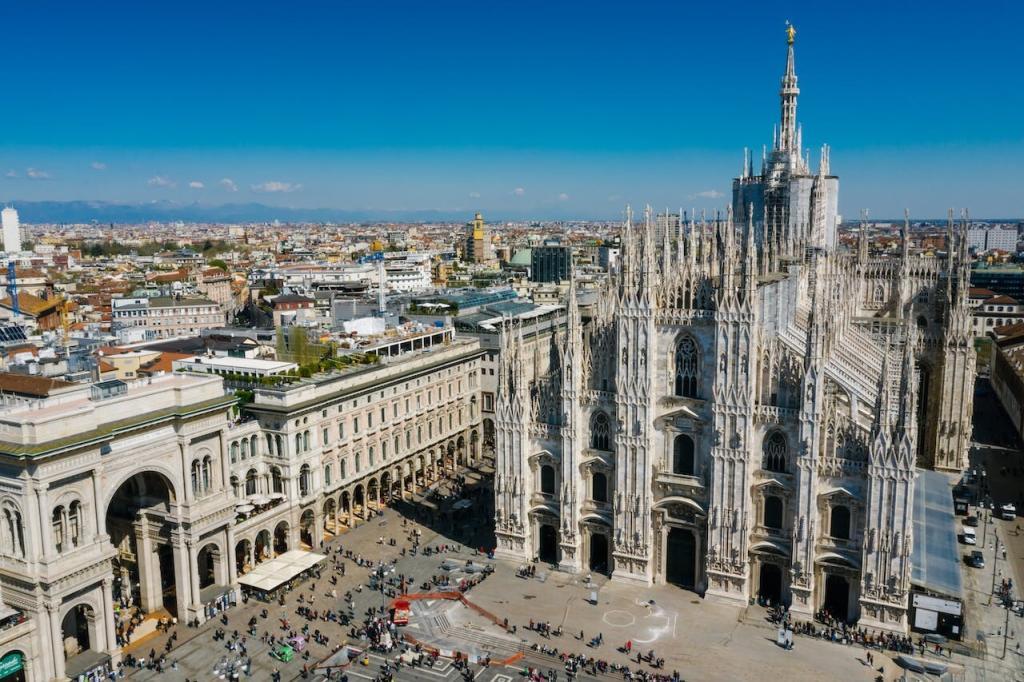
Living in Milan
Milan’s Unique Charm
Living in Milan is an exhilarating experience. The city exudes a unique charm with its stylish residents, historic architecture, and a passion for innovation. Many expats that move here say there is no place in the world like it. This blend of tradition and modernity creates a dynamic environment that appeals to a diverse range of people from expats to native Italians alike. Milan’s growing cultural importance brings many expats here for both work and pleasure, which makes it a very appealing destination for staying a long period of time.
Popular Neighborhoods in Milan
When living in Milan, there are many different distinct areas you may want to consider. Depending on your preferences, you are sure to find something that fits your desired lifestyle. Here are a few of the most famous places that people choose to live when moving here.
Brera
Brera is a picturesque, bohemian neighborhood known for its artistic ambiance. This district is home to numerous galleries, boutiques, and some of the best cafes in the city. It is both popular to expats and locals alike, making it a great place to be able to experience new culture while being easy to fall back on old styles.
Navigli
If you love a lively atmosphere, Navigli is perfect. It’s famous for its canals, vibrant nightlife, and a plethora of restaurants serving authentic Italian cuisine. This has become a very trendy place to live and popular amongst the younger people who want to live in Milan.
Porta Nuova
Porta Nuova has become one of the most popular areas to live in, especially for expats. This area has high-rises, great transportation, and many of the city’s biggest businesses. It is more akin to city life you may know from the states, with many modern amenities you’ve come to expect with city life.
There are many other amazing places to live in Milan, but those three are regarded as some of the most popular to live in.
Cost of Living in Milan as an America
One of the most popular questions for expats is “What is the Cost to Live in Milan?” Unfortunately, the answer to this can vary from person and it gets even more complicated for expats. Though there are some expenses that will be the same for citizens or expats. For example, a 1 Bedroom you can expect around 1000-2000 Euros a month which is around +/- 10% with the US dollar. Generally, many expats have told us the cost of living in Milan is around the same as most major American cities.
Exploring Milan’s Culture
Art and Museums
Pinacoteca di Brera: This renowned art gallery houses an impressive collection of Italian art, including works by Caravaggio and Raphael. It is the major museum in Milan and considered one of the best museums in the world.
Visit Pinacoteca di Brera
The Last Supper: This masterpiece by Leonardo da Vinci can be found in the Convent of Santa Maria delle Grazie. Make sure to book your tickets well in advance. The convent isn’t really a museum as there is only the single defining work that brings people in. Though there are other historic and beautiful pieces to see there.
Visit Santa Maria delle Grazie
Music and Opera
Milan is synonymous with opera. Don’t miss the chance to attend a performance at the famous La Scala, one of the most prestigious opera houses in the world. Founded in 1778, the opera house is almost as old as America!
Visit Teatro La Scala
Culinary Delights
Risotto alla Milanese: Savor the city’s signature dish, a creamy saffron-infused risotto. Its simplicity is deceiving as there is a plethora of flavors while seemingly few ingredients.
Aperitivo: Experience the Italian tradition of aperitivo, where you enjoy drinks and appetizers at local bars. Starting with a traditional spritz or negroni, the aperitivo helps people relax after work and start unwinding. For an expat living in Milan, aperitivo is much like a happy hour in the states.
Lifestyle and Entertainment of Milan
Fashion Capital
One of the things Milan is most known for is its importance in the fashion world. Some call it the fashion capital of the world with many shows that bring pros from all over the world. Take a stroll through the Quadrilatero della Moda, the city’s fashion district, where you can shop for luxury brands and the latest trends. The Milan fashion week takes place in late February, so look out for this if you’re interested.
Sports
If you’re a football enthusiast, attending an AC Milan or Inter Milan match at San Siro Stadium (Stadio Giuseppe Meazza) is a must. Milanese residents are passionate about their football. The San Siro can fit 80,000 people and has tours of the facilities and a museum with historic memorabilia.
Conclusion
Living in Milan as an expat is an experience that blends rich history, modernity, and cultural diversity compared to your times in the USA. This bustling metropolis offers a unique way of life that caters to various interests and passions. Whether you’re attracted to art, fashion, or simply the joy of living in a vibrant city, Milan has something to offer everyone. Embrace the Milanese lifestyle and enjoy the enchanting journey in the heart of Italy’s fashion and cultural capital.
Remember, Milan isn’t just a city; it’s a lifestyle.
We also have a page dedicated to Moving to Milan if you would like to get started or fill out our quote form at the top of the page. If you are interested in moving anywhere else in Italy, take a look at our Moving to Italy Guide.
Introduction
Welcome to the top ten list of the safest countries in the world. At Schumacher Cargo Logistics, we understand the importance of personal safety and security when considering international moving or travel. In this article, we will present a detailed overview of the top destinations that offer a peaceful and secure environment for individuals and families alike. By providing valuable insights and highlighting key safety factors, we aim to assist you in making informed decisions while planning your next adventure or permanent move.

How is Safest Country Measured
As per the Global Peace Index (GPI) published by The Institute for Economics and Peace (IEP), countries are ranked on several factors such as number of violent deaths, impact of terrorism, nuclear capability, conditions of peace, social security, internal conflicts, and international relations. There are 23 total indicators which you can read here.
We are using the 2023 version published of the GPI to rank and let you know what makes these the safest countries this year.
1. Iceland
Known for its stunning natural landscape, Iceland takes first place as the safest country in the world with a GPI score of 1.124. For 14 years Iceland continues to take this top spot and here are some reasons why Iceland is considered the safest country in the world:
Low crime rate
Iceland has one of the lowest crime rates globally. Violent crime is extremely rare, and the country experiences low levels of theft, robbery, and other criminal activities. This contributes to a sense of security for residents and visitors alike.
Strong rule of law
Iceland has a well-established legal system and a strong rule of law. The judiciary is independent, and the legal framework ensures the protection of individual rights and safety.
Effective law enforcement
The Icelandic police force is known for its professionalism and efficiency. They maintain a visible presence in the community and work diligently to prevent and combat crime.
Trust in institutions
Icelanders generally have high levels of trust in their institutions, including the police, government, and justice system. This trust fosters a sense of security and contributes to the overall safety of the country.
Social cohesion
Iceland has a close-knit community and a strong sense of social cohesion. This social fabric plays a role in preventing crime and maintaining a safe environment.
Low corruption levels
Iceland consistently ranks among the least corrupt countries globally. Transparency, accountability, and a strong anti-corruption framework contribute to the overall safety of the country.
Geographical isolation:
Iceland’s geographical location, situated in the North Atlantic, contributes to its safety. Its isolation makes it less vulnerable to external threats and conflicts that can affect other regions.
Focus on public welfare:
Iceland places a strong emphasis on social welfare and providing its citizens with a high quality of life. This includes access to healthcare, education, and social services, which contribute to a sense of security and well-being.
2. Denmark
Denmark consistently ranks as one of the top 5 safest countries in the world. renowned for its sustainable practices, bike-friendly cities, and renewable energy initiatives, Denmark continues to keep its citizens safe and happy.
Low crime rates:
Denmark has a relatively low crime rate, including low levels of violent crime and property crime. The country has effective law enforcement agencies that maintain public safety and work to prevent and investigate criminal activities.
Political stability:
Denmark is known for its political stability and well-functioning democratic institutions. The country has a long history of political stability, which contributes to a sense of security and trust in the government.
Strong social welfare system:
Denmark has a robust social welfare system that focuses on providing its citizens with a high quality of life. The availability of healthcare, education, and social services helps create a stable and secure society.
Transparency and low corruption:
Denmark consistently ranks as one of the least corrupt countries globally. Transparency, accountability, and an effective legal framework help maintain integrity within institutions and reduce corruption-related risks.
Well-developed infrastructure:
Denmark has a well-developed infrastructure, including reliable public transportation, well-maintained roads, and efficient emergency services. This contributes to a safe and secure environment for residents and visitors.
Trust in institutions:
Danes generally have a high level of trust in their institutions, such as the police, judiciary, and government. This trust fosters a sense of security and confidence in the functioning of the society.
Strong focus on community and social cohesion:
Denmark places emphasis on community engagement and social cohesion. This includes active citizen participation, strong community support networks, and a culture of looking out for one another, all of which contribute to a safe and inclusive society.
Quality healthcare system:
Denmark has a well-regarded healthcare system that ensures accessible and high-quality healthcare services for its residents. This contributes to overall public health and safety.
Moving to Denmark
3. Ireland
Ireland has risen to the 3rd place ranking as one of the safest countries in the world. In 2022 they jumped up from outside the top 10 to #3. With its warm and friendly people, its no wonder the Irish hospitality has made it rise on this list.
Low crime rates:
Ireland has relatively low crime rates, including low levels of violent crime and property crime. The country has effective law enforcement agencies that work to prevent and combat crime, contributing to a sense of safety.
Stable political environment:
Ireland has a stable political environment with a well-established democratic system. The country has a long history of peaceful transitions of power and strong democratic institutions, which contribute to a sense of security and stability.
Rule of law:
Ireland has a strong rule of law and an independent judiciary. The legal system ensures the protection of individual rights and provides a framework for maintaining public safety and order.
Community-oriented policing:
The Irish police, known as An Garda Síochána, are generally well-regarded for their community-oriented approach. They maintain a visible presence, engage with local communities, and work collaboratively to prevent and address crime.
High-quality healthcare system:
Ireland has a well-developed healthcare system that provides accessible and high-quality healthcare services. This contributes to public health and safety, ensuring that residents and visitors have access to necessary medical care.
Social cohesion:
Ireland is known for its strong sense of community and social cohesion. The country has a tradition of neighborliness and a culture of looking out for one another, which fosters a safe and supportive environment.
Natural beauty and rural safety:
Ireland’s rural areas are known for their natural beauty and generally low crime rates. The countryside offers a peaceful and secure atmosphere, attracting both residents and tourists seeking a safe environment.
Low terrorism threat:
Ireland has a low terrorism threat level. While historical conflicts and political tensions have existed, the peace process and reconciliation efforts have significantly contributed to reducing the risk of terrorism in the country.
Friendly and welcoming culture:
The Irish people are often described as friendly, welcoming, and helpful. This contributes to a positive and safe experience for visitors and residents alike.
Moving to Ireland
4. New Zealand
Taking the 4th spot this year, New Zealand has shown that its one of the safest countries in the world. The population is relatively small, and the people are known for their friendly and welcoming nature, making the countries exceptionally safe.
Low crime rates:
New Zealand has relatively low crime rates compared to many other countries. Violent crime rates are generally low, and the country experiences lower levels of theft and assault. The overall sense of safety is a result of effective law enforcement and a well-functioning justice system.
Political stability:
New Zealand has a stable political environment and a strong democratic system. Peaceful transitions of power, adherence to the rule of law, and robust democratic institutions contribute to a stable and secure society.
Trust in institutions:
New Zealanders generally have a high level of trust in their institutions, including the police, judiciary, and government. This trust fosters a sense of security and confidence in the functioning of society.
Strict firearms regulations:
New Zealand has strict firearms regulations in place, which helps reduce the risk of gun-related crimes. The government has implemented measures to control the possession and use of firearms, contributing to public safety.
Natural disaster preparedness:
New Zealand is prone to natural disasters such as earthquakes and volcanic activity. However, the country has developed advanced systems and infrastructure to prepare for and respond to these events, minimizing the risks to public safety.
Strong sense of community:
New Zealand has a strong sense of community and social cohesion. Kiwis are known for their friendliness, helpfulness, and willingness to look out for one another. This fosters a safe and supportive environment.
High-quality healthcare system:
New Zealand has a well-regarded healthcare system that provides accessible and high-quality healthcare services. The availability of healthcare contributes to public health and safety.
Beautiful natural environment:
New Zealand’s stunning natural landscapes and outdoor recreational opportunities are well-preserved and accessible to the public. This promotes a safe environment for outdoor activities and tourism.
Low terrorism threat:
New Zealand has a low terrorism threat level. While no country is entirely immune to risks, the country has implemented security measures and intelligence protocols to mitigate potential threats.
Moving to New Zealand
5. Austria
Austria closes the top 5 and there is no question they deserve it. The country offers a high standard of living, with a strong focus on education, healthcare, and social welfare, creating a very safe and peaceful society.
Low crime rates:
Austria has relatively low crime rates, including low levels of violent crime and property crime. The country has effective law enforcement agencies that work to prevent and combat crime, contributing to a sense of safety.
Stable political environment:
Austria has a stable political environment with a well-established democratic system. The country has a long history of political stability, strong democratic institutions, and respect for the rule of law, which contribute to a sense of security.
Trustworthy institutions:
Austrians generally have a high level of trust in their institutions, including the police, judiciary, and government. The trust in institutions fosters a sense of security and confidence in the functioning of society.
High-quality infrastructure:
Austria has a well-developed infrastructure, including reliable public transportation, well-maintained roads, and efficient emergency services. This contributes to a safe and secure environment for residents and visitors.
Social cohesion:
Austria has a strong sense of community and social cohesion. The country values solidarity and cooperation, creating a supportive environment where people look out for one another.
Focus on public welfare:
Austria places a strong emphasis on social welfare, providing its citizens with a high standard of living, healthcare, education, and social services. This focus on public welfare contributes to a sense of security and well-being.
Geographical location:
Austria’s central European location and peaceful surroundings contribute to its safety. It is not prone to natural disasters or geopolitical conflicts that can pose risks to public safety.
Low terrorism threat:
While no country is entirely immune to risks, Austria has a relatively low terrorism threat level. The country has implemented security measures and intelligence protocols to mitigate potential threats.
Moving to Austria
6. Singapore
With its booming growth, Singapore has become a global financial hub. This new modern infrastructure, efficient governance and small population, Singapore is able to keep the country very safe and peaceful.
Strict laws and regulations:
Singapore has a reputation for having strict laws and regulations that are strictly enforced. This includes laws related to public order, crime prevention, and personal safety. The strict legal framework contributes to a safe and secure environment.
Efficient law enforcement:
Singapore has a highly efficient and professional police force. The police maintain a visible presence in the community and actively work to prevent and combat crime. They are known for their quick response times and effective crime-solving capabilities.
Low crime rates:
Singapore has consistently low crime rates, including low levels of violent crime, theft, and burglary. The strong law enforcement presence and strict legal framework contribute to a safe and secure environment for residents and visitors.
Well-developed infrastructure:
Singapore has a well-developed infrastructure that includes efficient transportation systems, well-maintained roads, and advanced emergency services. This ensures the safety and security of its residents and visitors.
CCTV surveillance:
Singapore has an extensive network of closed-circuit television (CCTV) cameras installed in public areas. These cameras serve as a deterrent to crime and aid in crime prevention and detection.
Strong focus on public safety:
Singapore places a strong emphasis on public safety. The government implements proactive measures and public education campaigns to promote safety and raise awareness of potential risks.
Efficient legal system:
Singapore has an efficient and well-functioning legal system. The judiciary is independent, ensuring the fair administration of justice and the protection of individual rights. This contributes to a sense of security and trust in the legal system.
Low corruption levels:
Singapore consistently ranks as one of the least corrupt countries globally. Transparency, accountability, and a strong anti-corruption framework help maintain integrity within institutions and contribute to the overall safety of the country.
Moving to Singapore
7. Portugal
Portugal takes the 7th safest country in the world for 2023. They’ve been rising over the years with its progress after facing economic challenges in the past. Overall, Portugal is a captivating and welcoming country with a diverse cultural tapestry and a captivating blend of history and modernity.
Low crime rates:
Portugal has relatively low crime rates, including low levels of violent crime and property crime. The country has effective law enforcement agencies that work to prevent and combat crime, contributing to a sense of safety.
Stable political environment:
Portugal has a stable political environment with a well-established democratic system. The country has a history of political stability, strong democratic institutions, and respect for the rule of law, which contribute to a sense of security.
Strong social cohesion:
Portugal has a strong sense of community and social cohesion. Portuguese society values solidarity, mutual support, and a close-knit community, which contribute to a safe and harmonious environment.
Friendly and welcoming culture:
The Portuguese people are known for their warmth, friendliness, and hospitality. This contributes to a positive and safe experience for residents and visitors alike.
Well-developed infrastructure:
Portugal has a well-developed infrastructure, including reliable transportation systems, well-maintained roads, and efficient emergency services. This contributes to a safe and secure environment for residents and visitors.
Natural beauty and outdoor safety:
Portugal is known for its stunning natural landscapes and outdoor recreational opportunities. The country takes measures to ensure the safety of tourists and residents engaging in outdoor activities such as hiking, surfing, and exploring natural parks.
Low terrorism threat:
Portugal has a low terrorism threat level. The country has implemented security measures and intelligence protocols to mitigate potential threats.
Quality healthcare system:
Portugal has a well-regarded healthcare system that provides accessible and high-quality healthcare services. The availability of healthcare contributes to public health and safety.
Moving to Portugal
8. Slovenia
Taking the 8th spot, Slovenia is a peaceful and safe country, with a high quality of life and a well-developed healthcare and education system. The country has a strong focus on sustainability and eco-friendly practices, making it a destination for eco-tourism.
Low crime rates:
Slovenia has relatively low crime rates, including low levels of violent crime and property crime. The country has effective law enforcement agencies that work to prevent and combat crime, contributing to a sense of safety.
Political stability:
Slovenia has a stable political environment with a well-established democratic system. The country has a history of political stability, strong democratic institutions, and respect for the rule of law, which contribute to a sense of security.
Efficient law enforcement:
Slovenian police are known for their professionalism and efficiency. They maintain a visible presence in communities and actively work to prevent and address criminal activities.
Trustworthy institutions:
Slovenians generally have a high level of trust in their institutions, including the police, judiciary, and government. This trust fosters a sense of security and confidence in the functioning of society.
Low corruption levels:
Slovenia consistently ranks as one of the countries with low levels of corruption. Transparency, accountability, and a strong anti-corruption framework help maintain integrity within institutions and contribute to the overall safety of the country.
Quality healthcare system:
Slovenia has a well-developed healthcare system that provides accessible and high-quality healthcare services. The availability of healthcare contributes to public health and safety.
Natural beauty and outdoor safety:
Slovenia is known for its natural beauty, including picturesque landscapes, lakes, and mountains. The country takes measures to ensure the safety of tourists and residents engaging in outdoor activities such as hiking, skiing, and exploring national parks.
Geographical location:
Slovenia’s location in Central Europe and its peaceful surroundings contribute to its safety. It is not prone to natural disasters or geopolitical conflicts that can pose risks to public safety.
9. Japan
In terms of safety, Japan is often considered one of the safest countries in the world. The crime rate is relatively low, and Japanese society places a strong emphasis on respect for others and adherence to laws and regulations.
Low crime rates:
Japan has remarkably low crime rates, including low levels of violent crime and property crime. The country has effective law enforcement agencies that work diligently to prevent and address criminal activities, contributing to a sense of safety.
Strong law enforcement:
Japanese police are known for their professionalism, efficiency, and dedication to public safety. They maintain a visible presence in communities, actively engage with the public, and enforce laws rigorously.
Safe streets and public spaces:
Japan is known for its safe streets and public spaces. Public transportation systems, such as trains and buses, are reliable and well-maintained. Additionally, public areas are generally well-lit and monitored, contributing to a sense of security.
Strict gun control:
Japan has some of the strictest gun control laws in the world. The possession and use of firearms are highly regulated, significantly reducing the risk of gun-related crimes and mass shootings.
Efficient legal system:
Japan has an efficient and well-functioning legal system. The country places a strong emphasis on the rule of law and maintaining social order, ensuring that crimes are addressed promptly, and justice is served.
Social cohesion:
Japanese society values social cohesion and harmony. There is a strong emphasis on respect for others, discipline, and a collective sense of responsibility, which contributes to a safe and orderly environment.
Disaster preparedness:
Japan is prone to natural disasters such as earthquakes, typhoons, and tsunamis. The country has developed robust disaster preparedness measures, advanced early warning systems, and efficient emergency response protocols to minimize the impact of these disasters and ensure public safety.
High-quality infrastructure:
Japan has a well-developed infrastructure, including efficient transportation systems, well-maintained roads, and advanced healthcare facilities. This contributes to the overall safety and well-being of residents and visitors.
Moving to Japan
10. Switzerland
Finishing the list, Switzerland has a low crime rate and dedication to maintaining law and order. Overall, Switzerland’s safety can be attributed to its stable political environment, well-functioning institutions, and proactive approach to maintaining the well-being of its population. This makes Switzerland an attractive destination for travelers and residents seeking a secure and peaceful environment.
Low crime rates:
Switzerland has remarkably low crime rates, including low levels of violent crime and property crime. The country has effective law enforcement agencies that work diligently to prevent and address criminal activities, contributing to a sense of safety.
Political stability:
Switzerland has a long history of political stability, with a well-established democratic system and strong democratic institutions. The country’s political stability fosters a safe and secure environment for its residents and visitors.
Neutrality and peaceful history:
Switzerland has maintained a policy of neutrality for centuries, avoiding involvement in international conflicts. This has contributed to Switzerland’s peaceful history and the absence of internal or external conflicts that could pose risks to public safety.
Efficient law enforcement:
Swiss police are known for their professionalism, efficiency, and dedication to public safety. They maintain a visible presence in communities, actively engage with the public, and enforce laws rigorously.
Trustworthy institutions:
Switzerland has a strong rule of law and a high level of trust in its institutions, including the police, judiciary, and government. This fosters a sense of security and confidence in the functioning of society.
High-quality healthcare system:
Switzerland has a well-regarded healthcare system that provides accessible and high-quality healthcare services. The availability of healthcare contributes to public health and safety.
Safe infrastructure:
Switzerland has a well-developed and safe infrastructure, including efficient transportation systems, well-maintained roads, and reliable public services. This ensures the safety and security of its residents and visitors.
Natural disaster preparedness:
Switzerland is well-prepared for natural disasters such as avalanches and floods. The country has implemented advanced monitoring systems, effective warning systems, and emergency response protocols to minimize the risks and ensure public safety.
Moving to Switzerland
Conclusion
When it comes to exploring the world or finding a new place to call home, safety is a crucial factor to consider. In this article, we have highlighted ten exceptional countries that consistently rank among the safest in the world. While many share some factors such as a low crime rate, there are many things that set them apart from each other. Stay tuned for next year, maybe a new country will steal a spot on the list!
When you decide to move to one of these countries, Schumacher Cargo Logistics can help you take your belongings with you. From your household to vehicles, you can easily ship all your goods to where they need to go overseas.
To get started fill out our Online Quote Form and a representative will contact you soon.
Introduction
Denmark, an enchanting Nordic nation renowned for its opulent historical backdrop, breathtaking landscapes, and remarkable standard of living, has emerged as an alluring destination for those contemplating relocation. Nevertheless, akin to any other location, living in Denmark entails a set of advantages and disadvantages unique to the region. Within the confines of this article, we shall delve into the pros and cons of living in Denmark, providing a comprehensive overview of the experiences that await those who choose to embrace this captivating Scandinavian haven as their home.
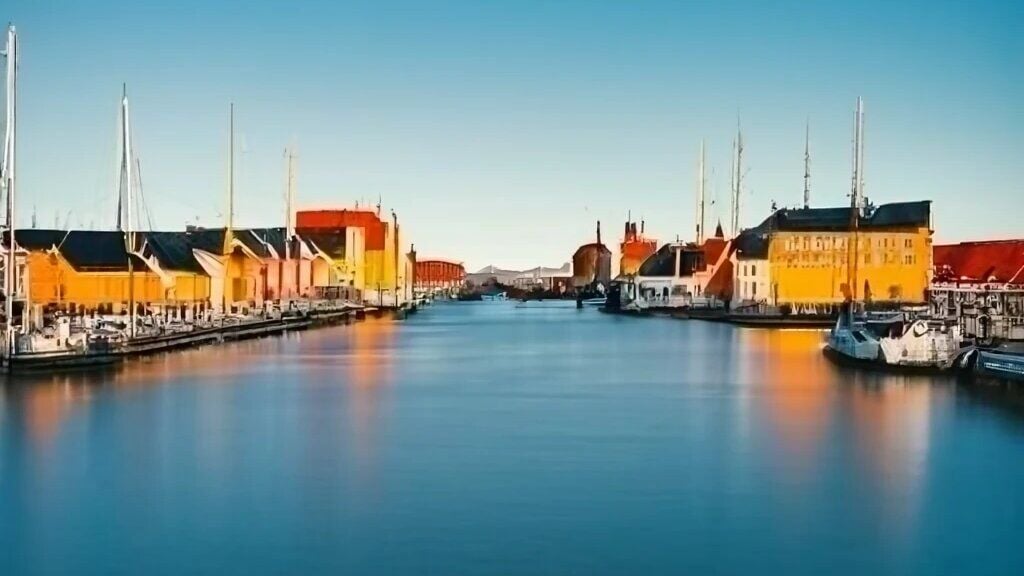
Disclaimer for Pros and Cons of Living in Denmark
As a disclaimer, there are variations in living in different places within Denmark. For instance, living in Copenhagen is different than living in Aarhus or Odense. In this article, the differences between Denmark and USA should be taken as more as a broad stroke, especially since each person can experience a completely different Denmark from each other.
Pros of Living in Denmark
Exemplary Quality of Life
Denmark consistently attains top rankings in terms of quality of life, boasting exceptional healthcare provisions, high educational benchmarks, and a robust social welfare system. Residents revel in a well-established infrastructure, pristine urban areas, and a profound sense of community. Denmark consistently ranks in the top 5 happiest countries in the world, which shows just how nice this is for the citizens here.
Prominent Focus on Work-Life Equilibrium
One of Denmark’s key advantages lies in its emphasis on achieving a harmonious work-life equilibrium. Danes truly value leisure time and prioritize personal well-being. With a condensed workweek and ample vacation entitlements, individuals have an abundance of time to indulge in hobbies, spend quality moments with their loved ones, and relish recreational pursuits. Many will find the minimum time off from a full-time job will be 4 weeks, which is much from than the USA. Some may even find themselves with over 3 months off during a year.
Top Tier Education System
Denmark has garnered a stellar reputation for its education system of the highest caliber. From the formative years of primary school to the expanse of university education, students are privileged to be part of a comprehensive and inclusive learning environment. The pedagogical focus on critical thinking, creativity, and practical skills equips students with the tools necessary for future triumphs.
Sustainable and Ecological Lifestyle
Denmark remains unswerving in its commitment to sustainability and environmental conservation. Spearheading the charge in renewable energy production, the nation’s landscape is adorned with wind turbines. The emphasis placed on cycling as a mode of transportation, the efficiency of public transit systems, and the cultivation of eco-friendly practices renders Denmark an idyllic haven for conscientious individuals passionate about the environment.
Safety and Security
Denmark consistently secures a place among the world’s safest countries. Low crime rates, efficient law enforcement agencies, and a prevailing sense of social cohesion contribute to an atmosphere of safety and security for all residents. Whether navigating the urban streets or venturing into the countryside, one can traverse with confidence, reassured by personal well-being. Some American expats feel so safe, they leave their doors unlocked for their friends to come and go.
Cons of Living in Denmark
Cost of Living in Denmark
One primary concern associated with living in Denmark pertains to the elevated cost of living. The nation upholds a high tax rate, and everyday expenditures, such as housing, groceries, and transportation, can prove rather dear. Therefore, meticulous budgeting and preparedness for comparatively higher prices vis-à-vis other countries are imperative. If you retain your US citizenship, you’ll actually need to pay taxes to both governments which can make living in Denmark very expensive for Americans.
Language Barrier
While many Danes possess a fluent command of the English language, Danish remains the official language of Denmark. For those intending to live and work in Denmark, acquiring proficiency in the local language bears inherent advantages for everyday life and seamless integration. Though Danish might present challenges on the path to mastery, the effort expended serves to enrich one’s overall experience.
Climate
Denmark experiences a temperate climate characterized by mild summers and chilly winters. Unpredictable weather patterns, frequent rain showers, and overcast skies are par for the course. Those inclined toward warmer climes or susceptible to colder temperatures may encounter some adjustment hurdles when acclimatizing to the Danish weather.
Limited Employment Opportunities
The Danish job market exhibits a competitive landscape, particularly for non-Danish speakers. Fluency in the Danish language is often a prerequisite for certain professions, consequently limiting opportunities for expatriates. Thorough research of the job market and a careful assessment of one’s skills and qualifications are essential steps before embarking on a relocation journey.
Cultural Adaptation
Relocating to a foreign land invariably necessitates cultural adaptation. Although Denmark is renowned for its inclusive and welcoming society, individuals hailing from diverse cultural backgrounds may encounter initial challenges. Familiarizing oneself with Danish customs, norms, and social etiquette proves instrumental in facilitating integration and nurturing meaningful connections.
Frequently Asked Questions about Living in Denmark
Is Denmark considered a safe country to call home?
Certainly, Denmark stands tall among the world’s safest countries. The combination of low crime rates, efficient law enforcement, and a robust social fabric engenders a secure living environment.
How steep is the cost of living in Denmark?
Denmark boasts a high cost of living, with expenses such as housing, groceries, and transportation carrying substantial price tags. Meticulous budgeting and preparedness for higher prices compared to other nations are essential for a smooth transition.
Is it necessary to learn Danish to thrive in Denmark?
While many Danes are proficient in English, acquainting oneself with the Danish language proves advantageous for daily life and seamless integration. Danish serves as the official language, and embracing it heightens the overall experience.
What characterizes the Danish education system?
Denmark’s education system is widely acclaimed for its adherence to high standards. From primary school through university, students are nurtured within a comprehensive and inclusive educational environment that fosters critical thinking, creativity, and practical skills.
How is work-life balance cultivated in Denmark?
Denmark places substantial emphasis on cultivating a healthy work-life balance. With shorter workweeks and generous vacation entitlements, individuals gain ample time to pursue personal interests, relish family moments, and savor leisurely pursuits.
What are some popular attractions in Denmark?
Denmark presents an array of enticing attractions for both residents and visitors. Tivoli Gardens, the picturesque Nyhavn waterfront, the historically captivating city of Copenhagen, and the enchanting castles of North Zealand rank among the popular destinations.
Conclusion to Living in Denmark Pros and Cons
Living in Denmark unfurls a tapestry of opportunities and experiences. The exceptional quality of life, steadfast dedication to work-life balance, and unwavering commitment to sustainability render this nation an irresistible destination for many. However, it is crucial to consider factors such as the cost of living, language barrier, and cultural adaptation before embarking on a journey of relocation. By carefully weighing the pros and cons, individuals can determine if living in Denmark aligns with their aspirations and goals.
Additional Reading
If you decide that the pros outweigh the cons to living in Denmark, Schumacher Cargo Logistics can help you move there. From your household to vehicles, you can easily ship all your goods to even the smallest towns.
To get started fill out our Online Quote Form and a representative will contact you soon!
The 1990s was a great era for American cars, with many iconic models being produced. There are so many amazing American cars from the 90s that it’s hard to break down a list of our favorites. These cars were all highly sought after in their day, and they continue to be cherished by car enthusiasts today. Each represents the best of American automotive engineering and design during the 1990s.
Here are our top 10 cars in America made during the 90s.
1. Dodge Viper Gen 1:
The Viper was introduced in 1992 and has built its case to be an American classic. It features a massive V10 engine producing 400 horsepower, and its sleek, muscular styling helps make it one of the most iconic American cars from the 1990s. It’s focus on straight speed is indicative of the times, where going fast in one direction was the key. The car’s 8.0-liter V10 engine produces an impressive 400 horsepower and 465 lb-ft of torque. In this specification, the car went to a top speed of 180 mph and a 0-60 mph time of 4.6 seconds. This power is complemented by a lightweight body made of aluminum and composite materials, which helps to improve the car’s handling and overall performance. Now you can find Gen 1 Dodge Vipers selling in the hundreds of thousands of dollars, showing its timelessness and desirability even today.
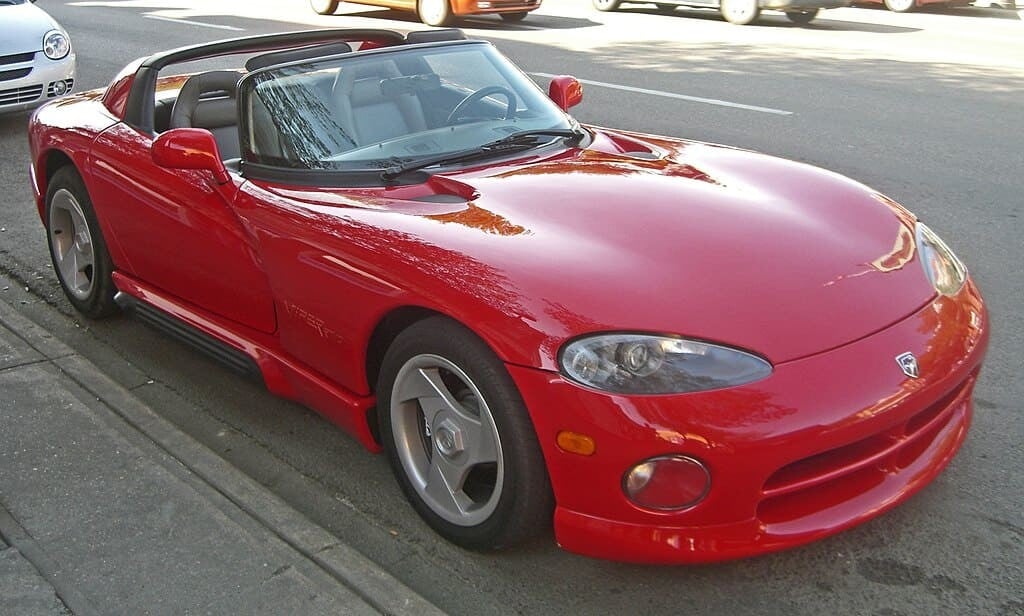
Myke2020 at en.wikipedia Crop: Cornischong at lb.wikipedia, Public domain, via Wikimedia Commons
2. Chevrolet Corvette ZR-1 (C4):
The Corvette was in its fourth generation (C4), which was designed to be sleeker and more modern than the C3 Stingray. The ZR-1 was a high-performance variant of the already-impressive Corvette, featuring a special engine developed by Lotus that produced up to 375 horsepower. Later in 1993, a 405HP version entered the market. This high-powered machine is nicknamed “Corvette from Hell,” and was one of the most expensive cars produced in America at the time. It was the first American car to exceed 400 horsepower, and its advanced technology and sleek styling made it a standout in the sports car market. This allowed it to stand on the same stage as the best European and Asian cars at the time. With its high power and great handling, the Corvette ZR-1 C4 was one of the top American cars from the 90s.
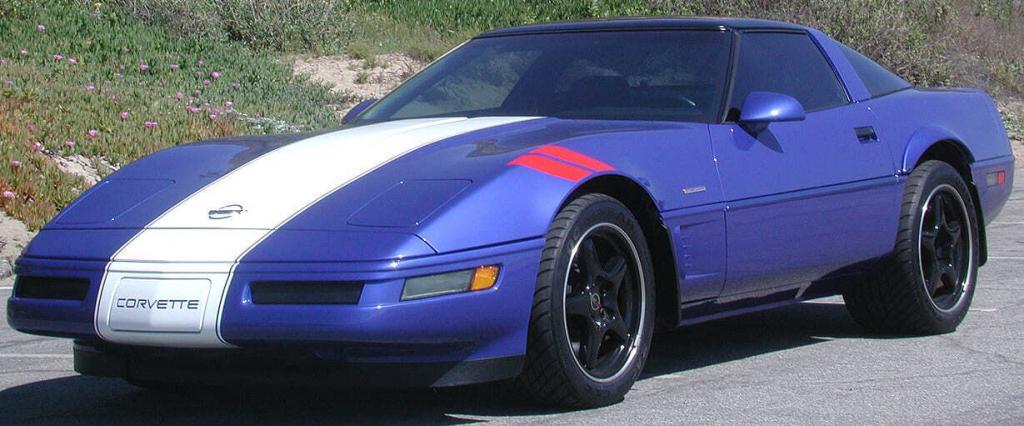
GrandSport at English Wikipedia, Public domain, via Wikimedia Commons
3. Ford Mustang SVT Cobra:
The SVT Cobra was a high-performance version of the Mustang produced by Ford’s Special Vehicle Team. It featured a powerful V8 engine as well as several other performance enhancements that made it one of the most capable Mustangs ever produced. There were different design refreshes of the Mustang during the 90s and the SVT Cobras shared these changes. The Fox Body was used for the early 90s and then later swapped off to the SN-95 body through the rest of the 90s. The fastest 90s Mustang was the 1998 SVT Cobra which had 305HP and had a 0-60 in 5.4 seconds. As the most powerful version one of the most popular muscle cars, the Mustang SVT Cobra takes a spot as one of the top American cars of the 90s.

InSapphoWeTrust from Los Angeles, California, USA, CC BY-SA 2.0, via Wikimedia Commons
4. Jeep Grand Cherokee (ZJ):
While the Jeep Grand Cherokee is not the fastest or the fanciest looking, it deserves to be on a list of the top American cars from the 90s. Introduced in 1993, this luxury SUV innovated a segment of the auto industry. This was one of the first SUVs to offer a combination of off-road capabilities and luxurious features. The Grand Cherokee was known for its ruggedness and ability to handle tough terrain, while also offering a comfortable ride and a range of high-end amenities. They did not skimp on reliability, as you can still see this car driven daily even to this day. Now it is not uncommon to see a luxury SUV that handles rough drives, but during the 90s the Jeep Grand Cherokee stood out.
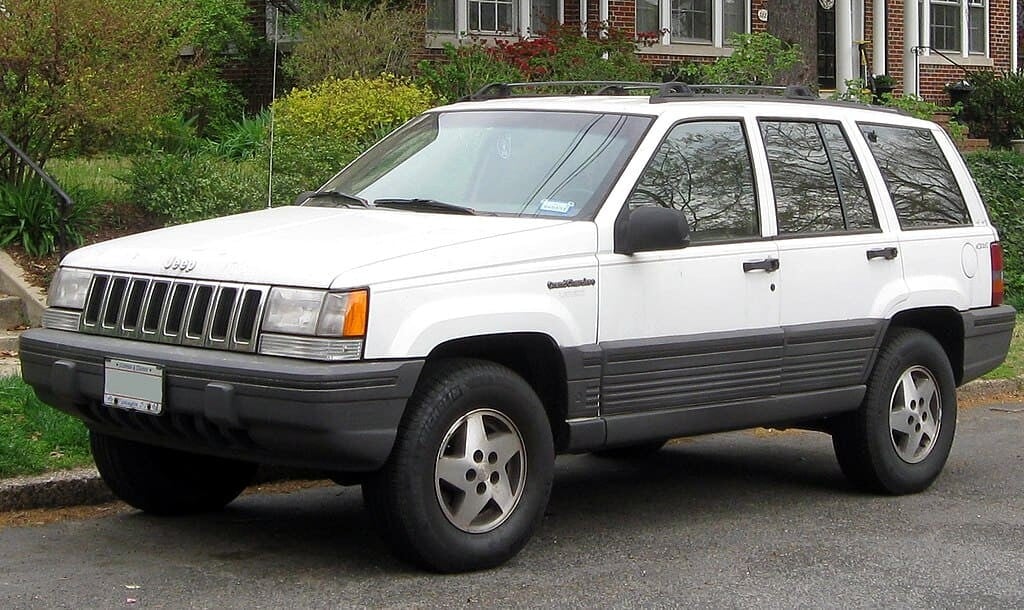
IFCAR, Public domain, via Wikimedia Commons
5. Chevrolet Impala SS:
Priced at $23,585, the Impala SS is full-size sedan produced from 1994 to 1996. It was powered by a 5.7-liter V8 engine that produced 260 horsepower. Interestingly, it used a modified engine from the Corvette and Camaro at the time. The Impala SS was very famous for its appearances in popular media such as movies, TV, and music. Moving away from old Impalas, the Impala SS was designed to be a performance car as an upgraded Caprice. This more powerful design had a lasting impact on many and gave people a new look into the model. With its power and huge cultural importance, the Impala SS is one of the top American cars during the 90s.
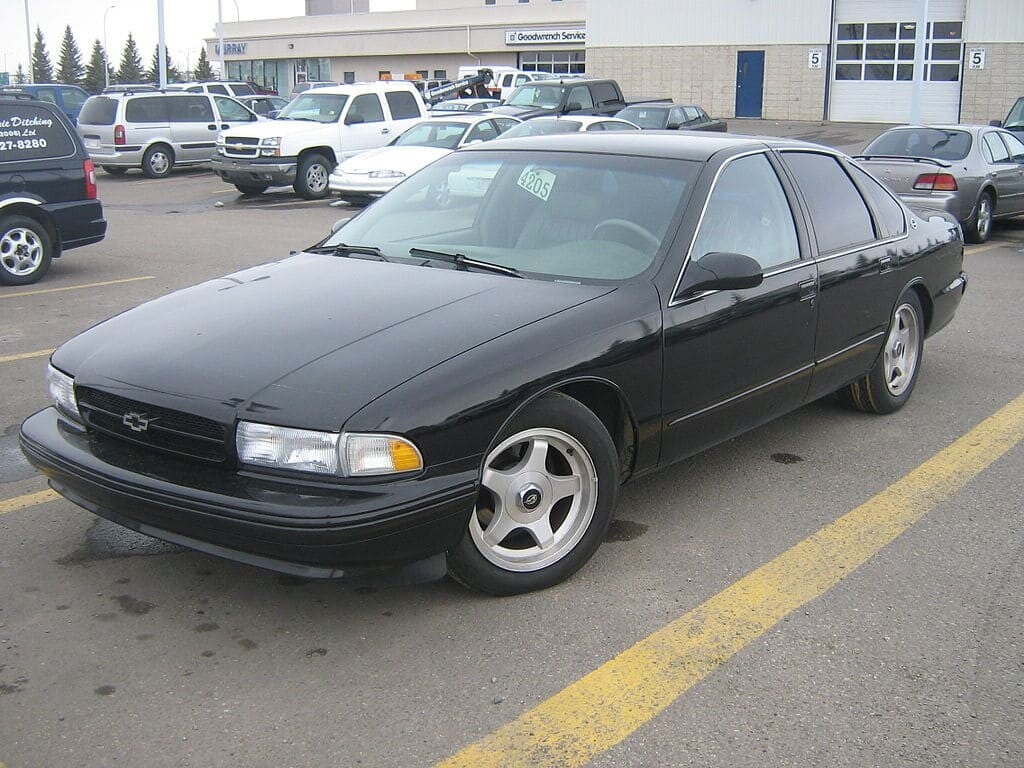
dave_7 from Lethbridge, Canada, CC BY-SA 2.0, via Wikimedia Commons
6. Pontiac Firebird Trans Am:
The Firebird Trans Am was a high-performance version of Pontiac’s popular muscle car. Featuring a V8 engine that produced 305 horsepower, the Firebird is one of the most powerful at the time. Its bold styling, with its distinctive hood scoop and rear spoiler, helped to make it one of the most recognizable American cars of the 1990s. Once you’ve seen a Firebird, you’ll be able to recognize them whenever you see them. There are few vehicles more distinguishable from the sounds and design than the Firebird Trans Am.
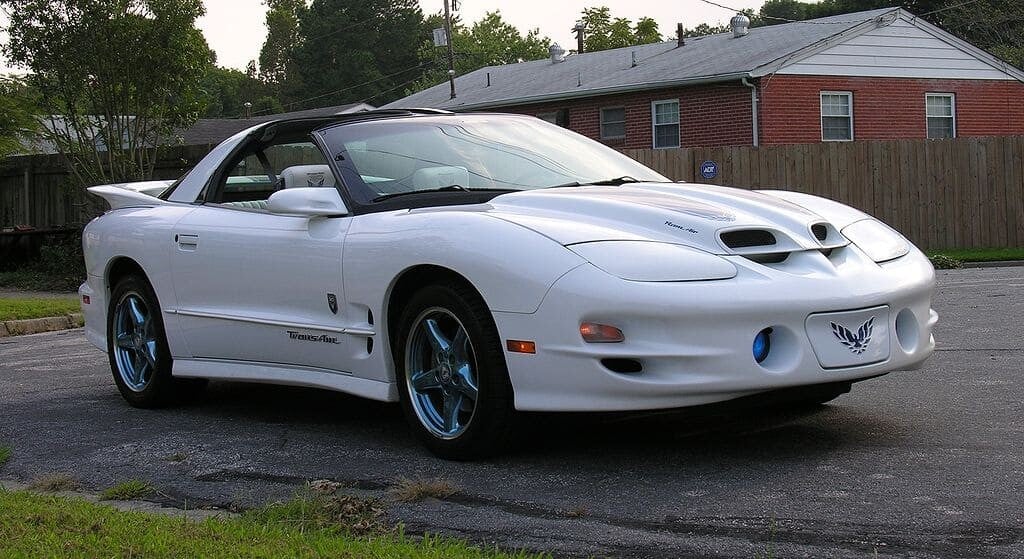
Mindlessmaggots, CC BY-SA 3.0, via Wikimedia Commons
7. Chevrolet Camaro Z28 SS:
The Camaro Z28 was a high-performance version of Chevy’s iconic muscle car, featuring a V8 engine that produced up to 330 horsepower. Its aggressive styling, with its sharp lines and bold graphics, helped to make it a favorite among car enthusiasts. The Camaro and Mustang were fierce rivals during the pony car era of the 90s. Each trying to one up each other, this competition raged hard. These muscle cars were so fierce that their rivalry was known by people who did not even follow car news. With the pony era, muscle car fans got to choose from 2 of the top American cars of the 90s.
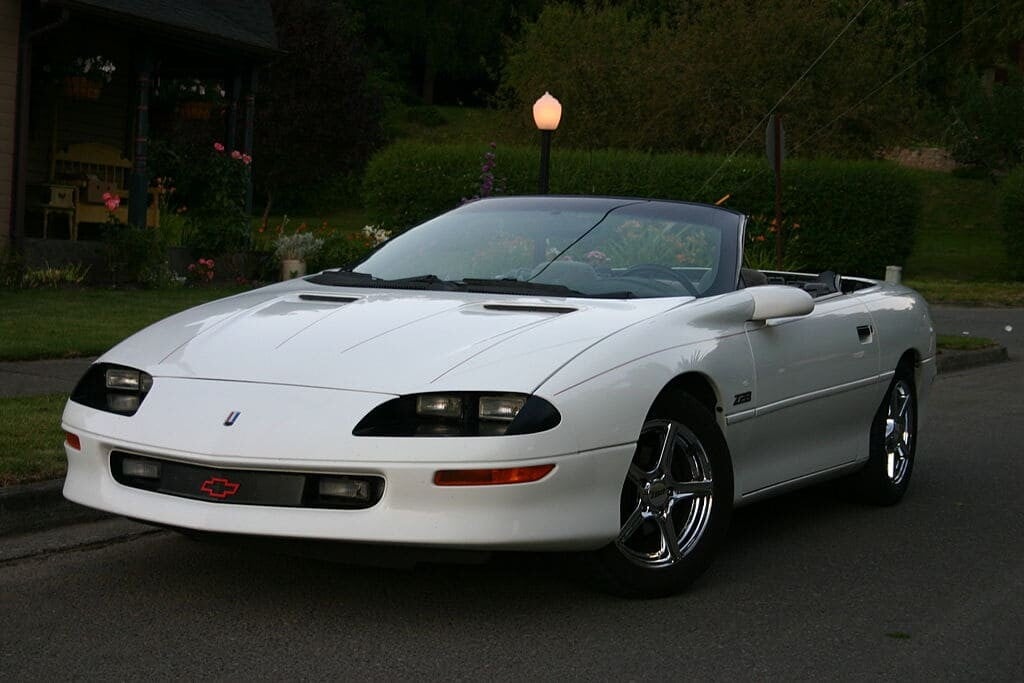
Mindlessmaggots, CC BY-SA 3.0, via Wikimedia Commons
8. Lincoln Mark VIII LSC:
Priced at $41,600, the Mark VIII LSC was a luxury coupe that was produced from 1993 to 1998. It was powered by a 4.6-liter V8 engine that produced 290 horsepower. This power put the Mark VIII at the top with some of the most powerful engines being produced at the time. One of the most notable features of the Mark VIII was its advanced technology, which included a digital instrument cluster, automatic climate control, and a premium sound system. Of course now and days, all of those features are standard even in some of the most budget vehicles. Though at the time, the Lincoln Mark VIII was a true test to luxury in the 90s.
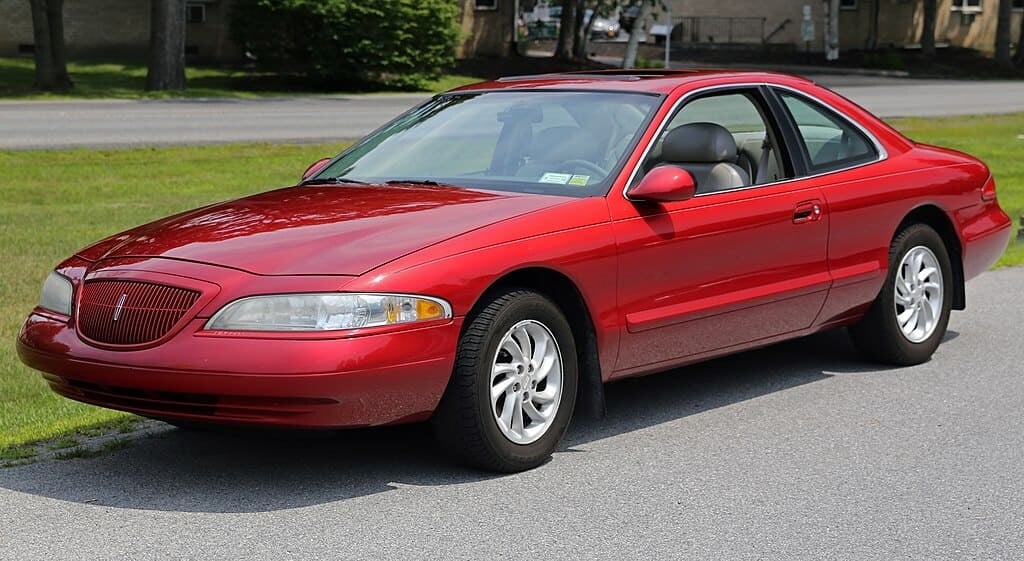
Mr.choppers, CC BY-SA 3.0, via Wikimedia Commons
9. Cadillac Allante
One of the most expensive American cars during the 90s was the Cadillac Allante. While more expensive cars exist, the Allante sold to a commercial audience. Listed at $60,000 in 1993, that would be around $125,000 in 2023. This price competes with luxury cars in Europe like Mercedes and Jaguar. While many believe that this car could compete, production was relatively low. Now the car is quite rare and could go in a museum if the condition is good. The Allante was one of the attempts from an American company to fight in the super luxury market, and that’s why it has a spot in the top American cars of the 90s.
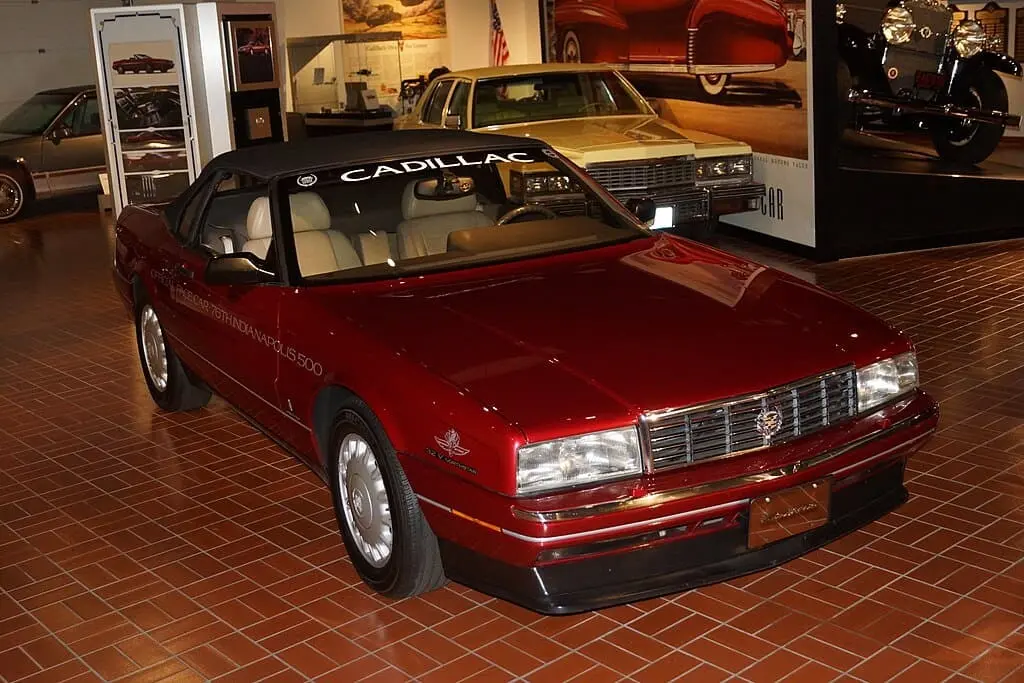
Greg Gjerdingen from Willmar, USA, CC BY 2.0, via Wikimedia Commons
10. Ford Taurus
For most Americans, the other cars on this list were very expensive and unobtainable. The Ford Taurus is the exact opposite, which is why it was the best-selling American car during the 90s. There was a period where you could not go outside and not see a Taurus on the street. From taxis to police and tv to movies, the Ford Taurus took hold in every aspect of American life.
The Taurus was a revolutionary car, featuring a sleek, aerodynamic design that set it apart from its competitors. Over the years, the Taurus has undergone several redesigns and updates, and it remains a popular car to this day. The Taurus has a range of engine options, including a V6 and a high-performance SHO (Super High Output) V6. The Taurus SHO, produces up to 235 horsepower and went faster than the standard one. Other body types exhisted such as an enlarged wagon version as well. As the most sold American car in the 90s, the Ford Taurus is a great end to this list.
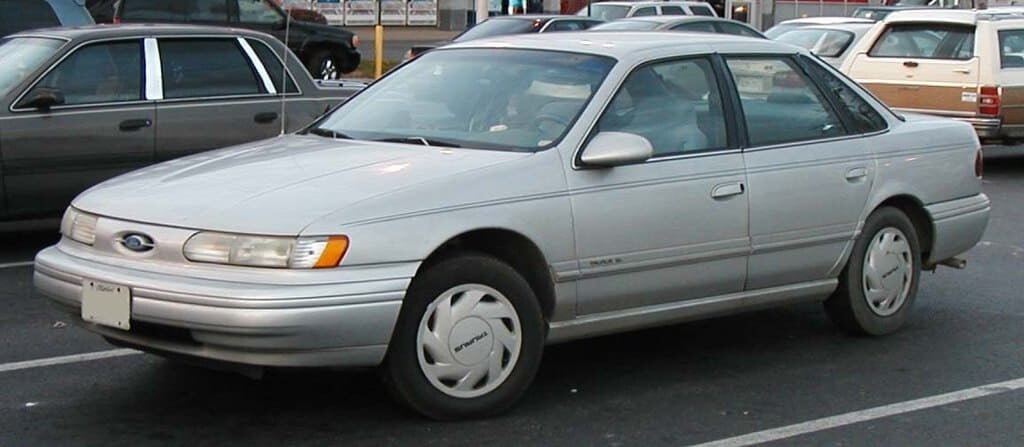
IFCAR, Public domain, via Wikimedia Commons
Top 10 American Cars from the 90s Conclusion
The 1990s were a decade of significant innovation and transformation in the American automotive industry. Characterized by sleek designs, advanced technology, and powerful engines the cars of the 90s pushed the boundaries of what was possible. From the speed stars Dodge Viper and Chevrolet Corvette to the revolutionary Ford Taurus and the luxury Cadillac Allante, there are many cars that deserve to take a place in the top American cars in the 90s. Whether you were a fan of sports cars, luxury sedans, or practical family vehicles, there was something for everyone in the American car market. These cars not only represented a significant chapter in American automotive history, but they also set the stage for the innovation and advancement that would continue into the 21st century.
More Reading
At Schumacher Cargo Logistics, we can ship these amazing American cars from the 90s all over the world. Read our page on International Car Shipping for more information.
Read about our Top 10 European Cars from the 90s to see our favorite cars made in Europe during the same decade.















